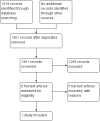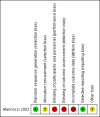Single crowns versus conventional fillings for the restoration of root-filled teeth
- PMID: 26403154
- PMCID: PMC7111426
- DOI: 10.1002/14651858.CD009109.pub3
Single crowns versus conventional fillings for the restoration of root-filled teeth
Abstract
Background: Endodontic treatment involves removal of the dental pulp and its replacement by a root canal filling. Restoration of root filled teeth can be challenging due to structural differences between vital and non-vital root-filled teeth. Direct restoration involves placement of a restorative material e.g. amalgam or composite, directly into the tooth. Indirect restorations consist of cast metal or ceramic (porcelain) crowns. The choice of restoration depends on the amount of remaining tooth, and may influence durability and cost. The decision to use a post and core in addition to the crown is clinician driven. The comparative clinical performance of crowns or conventional fillings used to restore root-filled teeth is unknown. This review updates the original, which was published in 2012.
Objectives: To assess the effects of restoration of endodontically treated teeth (with or without post and core) by crowns versus conventional filling materials.
Search methods: We searched the following databases: the Cochrane Oral Health Group's Trials Register, CENTRAL, MEDLINE via OVID, EMBASE via OVID, CINAHL via EBSCO, LILACS via BIREME. We also searched the reference lists of articles and ongoing trials registries.There were no restrictions regarding language or date of publication. The search is up-to-date as of 26 March 2015.
Selection criteria: Randomised controlled trials (RCTs) or quasi-randomised controlled trials in participants with permanent teeth that have undergone endodontic treatment. Single full coverage crowns compared with any type of filling materials for direct restoration or indirect partial restorations (e.g. inlays and onlays). Comparisons considered the type of post and core used (cast or prefabricated post), if any.
Data collection and analysis: Two review authors independently extracted data from the included trial and assessed its risk of bias. We carried out data analysis using the 'treatment as allocated' patient population, expressing estimates of intervention effect for dichotomous data as risk ratios, with 95% confidence intervals (CI).
Main results: We included one trial, which was judged to be at high risk of performance, detection and attrition bias. The 117 participants with a root-filled, premolar tooth restored with a carbon fibre post, were randomised to either a full coverage metal-ceramic crown or direct adhesive composite restoration. None experienced a catastrophic failure (i.e. when the restoration cannot be repaired), although only 104 teeth were included in the final, three-year assessment. There was no clear difference between the crown and composite group and the composite only group for non-catastrophic failures of the restoration (1/54 versus 3/53; RR 0.33; 95% CI 0.04 to 3.05) or failures of the post (2/54 versus 1/53; RR 1.96; 95% CI 0.18 to 21.01) at three years. The quality of the evidence for these outcomes is very low. There was no evidence available for any of our secondary outcomes: patient satisfaction and quality of life, incidence or recurrence of caries, periodontal health status, and costs.
Authors' conclusions: There is insufficient evidence to assess the effects of crowns compared to conventional fillings for the restoration of root-filled teeth. Until more evidence becomes available, clinicians should continue to base decisions about how to restore root-filled teeth on their own clinical experience, whilst taking into consideration the individual circumstances and preferences of their patients.
Conflict of interest statement
There are no financial conflicts of interest and the review authors declare that they do not have any associations with any parties who may have vested interests in the results of this review.
Figures




Update of
-
Single crowns versus conventional fillings for the restoration of root filled teeth.Cochrane Database Syst Rev. 2012 May 16;(5):CD009109. doi: 10.1002/14651858.CD009109.pub2. Cochrane Database Syst Rev. 2012. Update in: Cochrane Database Syst Rev. 2015 Sep 25;(9):CD009109. doi: 10.1002/14651858.CD009109.pub3. PMID: 22592736 Updated.
Comment in
-
Insufficient evidence on whether to restore root-filled teeth with single crowns or routine fillings.Evid Based Dent. 2016 Jun;17(2):50-1. doi: 10.1038/sj.ebd.6401170. Evid Based Dent. 2016. PMID: 27339239
Similar articles
-
Single crowns versus conventional fillings for the restoration of root filled teeth.Cochrane Database Syst Rev. 2012 May 16;(5):CD009109. doi: 10.1002/14651858.CD009109.pub2. Cochrane Database Syst Rev. 2012. Update in: Cochrane Database Syst Rev. 2015 Sep 25;(9):CD009109. doi: 10.1002/14651858.CD009109.pub3. PMID: 22592736 Updated.
-
Preformed crowns for decayed primary molar teeth.Cochrane Database Syst Rev. 2015 Dec 31;2015(12):CD005512. doi: 10.1002/14651858.CD005512.pub3. Cochrane Database Syst Rev. 2015. PMID: 26718872 Free PMC article.
-
Metal-free materials for fixed prosthodontic restorations.Cochrane Database Syst Rev. 2017 Dec 20;12(12):CD009606. doi: 10.1002/14651858.CD009606.pub2. Cochrane Database Syst Rev. 2017. PMID: 29261853 Free PMC article.
-
WITHDRAWN: Dental fillings for the treatment of caries in the primary dentition.Cochrane Database Syst Rev. 2016 Oct 17;10(10):CD004483. doi: 10.1002/14651858.CD004483.pub3. Cochrane Database Syst Rev. 2016. PMID: 27748505 Free PMC article.
-
Dental fillings for the treatment of caries in the primary dentition.Cochrane Database Syst Rev. 2009 Apr 15;(2):CD004483. doi: 10.1002/14651858.CD004483.pub2. Cochrane Database Syst Rev. 2009. Update in: Cochrane Database Syst Rev. 2016 Oct 17;10:CD004483. doi: 10.1002/14651858.CD004483.pub3. PMID: 19370602 Updated.
Cited by
-
Assessment of Periodontitis Risk Factors in Endodontically Treated Teeth: A Cross-Sectional Study.Diagnostics (Basel). 2024 Sep 6;14(17):1972. doi: 10.3390/diagnostics14171972. Diagnostics (Basel). 2024. PMID: 39272756 Free PMC article.
-
An Umbrella Review of Systematic Reviews and Meta-Analyses Evaluating the Success Rate of Prosthetic Restorations on Endodontically Treated Teeth.Int J Dent. 2022 Feb 22;2022:4748291. doi: 10.1155/2022/4748291. eCollection 2022. Int J Dent. 2022. PMID: 35242190 Free PMC article. Review.
-
Study on the effect of simulation-based case teaching method on the preclinical teaching of tooth defects restoration.BMC Med Educ. 2025 Apr 5;25(1):487. doi: 10.1186/s12909-025-07010-3. BMC Med Educ. 2025. PMID: 40188128 Free PMC article.
-
Interdisciplinary Delphi study by PROSEC North America: Recommendations on single indirect restorations made from ceramic and nonmetallic biomaterials for posterior teeth.J Esthet Restor Dent. 2025 Mar;37(3):809-820. doi: 10.1111/jerd.13289. Epub 2024 Aug 2. J Esthet Restor Dent. 2025. PMID: 39093128 Free PMC article.
-
The Success of Endodontic Treatments Performed by Dental Residents in Advanced Education in General Dentistry Program: A 10-Year Retrospective Study.Dent J (Basel). 2025 Jul 8;13(7):306. doi: 10.3390/dj13070306. Dent J (Basel). 2025. PMID: 40710151 Free PMC article.
References
References to studies included in this review
Mannocci 2002 {published data only}
-
- Mannocci F, Bertelli E, Sherriff M, Watson TF, Ford TR. Three‐year clinical comparison of survival of endodontically treated teeth restored with either full cast coverage or with direct composite restoration. Journal of Prosthetic Dentistry 2002;88(3):297‐301. - PubMed
References to studies excluded from this review
Basrani 2004 {published data only}
-
- Basrani B, Matthews D. Survival rates similar with full cast crowns and direct composite restorations. Evidence‐Based Dentistry 2004;5(2):45. - PubMed
Bitter 2010 {published data only}
-
- Bitter K, Meyer‐Lueckel H, Fotiadis N, Blunck U, Neumann K, Kielbassa AM, et al. Influence of endodontic treatment, post insertion, and ceramic restoration on the fracture resistance of maxillary premolars. International Endodontic Journal 2010;43(6):469‐77. - PubMed
Fokkinga 2007 {published data only}
-
- Fokkinga WA, Kreulen CM, Bronkhorst EM, Creugers NHJ. Up to 17‐year controlled clinical study on post‐and‐cores and covering crowns. Journal of Dentistry 2007;35(10):778‐86. - PubMed
Fokkinga 2008 {published data only}
-
- Fokkinga WA, Kreulen CM, Bronkhorst EM, Creugers NH. Composite resin core‐crown reconstructions: an up to 17‐year follow‐up of a controlled clinical trial. International Journal of Prosthodontics 2008;21(2):109‐15. - PubMed
Mannocci 2003 {published data only}
-
- Mannocci F, Bertelli E, Watson TF, Ford TP. Resin‐dentin interfaces of endodontically‐treated restored teeth. American Journal of Dentistry 2003;16(1):28‐32. - PubMed
Additional references
Aquilino 2002
-
- Aquilino SA, Caplan DJ. Relationship between crown placement and the survival of endodontically treated teeth. Journal of Prosthetic Dentistry 2002;87(3):256‐63. - PubMed
Bayne 2005
-
- Bayne SC, Schmalz G. Reprinting the classic article on USPHS evaluation methods for measuring the clinical research performance of restorative materials. Clinical Oral Investigations 2005;9(4):209‐14. - PubMed
Bjertness 1990
-
- Bjertness E, Sønju T. Survival analysis of amalgam restorations in long‐term recall patients. Acta Odontologica Scandinavica 1990;48(2):93‐7. - PubMed
Bolla 2007
Brown 2006
Cohen 2006
-
- Cohen S, Hargreaves KM. Pathways of the Pulp. 9th Edition. St Louis: Mosby, 2006.
CONSORT 2010
-
- Schulz KF, Altman DG, Moher D, for the CONSORT Group. CONSORT 2010 Statement: updated guidelines for reporting parallel group randomised trials. Trials 2010, 11:32. (24 March 2010). http://www.consort‐statement.org/consort‐2010 (accessed 10 August 2015). - PMC - PubMed
Da Rosa Rodolpho 2006
-
- Rosa Rodolpho PA, Cenci MS, Donassollo TA, Loguércio AD, Demarco FF. A clinical evaluation of posterior composite restorations: 17‐year findings. Journal of Dentistry 2006;34(7):427‐35. - PubMed
Egger 1997
Evidence‐Based Review 2009
-
- Evidence‐Based Review of Clinical Studies on Restorative Dentistry. Journal of Endodontics 2009; Vol. 35, issue 8:1111‐5. - PubMed
Gutmann 1992
-
- Gutmann JL. The dentin‐root complex: anatomic and biologic considerations in restoring endodontically treated teeth. Journal of Prosthetic Dentistry 1992;67(4):458‐67. - PubMed
Hemmings 2000
-
- Hemmings KW, Darbar UR, Vaughan S. Tooth wear treated with direct composite restorations at an increased vertical dimension: results at 30 months. Journal of Prosthetic Dentistry 2000;83(3):287‐93. - PubMed
Heydecke 2002
-
- Heydecke G, Peters MC. The restoration of endodontically treated, single‐rooted teeth with cast or direct posts and cores: a systematic review. Journal of Prosthetic Dentistry 2002;87(4):380‐6. - PubMed
Higgins 2003
Higgins 2011
-
- Higgins JPT, Green S (editors). Cochrane Handbook for Systematic Reviews of Interventions version 5.1.0 (updated March 2011). The Cochrane Collaboration, 2011. Available from www.cochrane‐handbook.org.
Loe 1963
-
- Loe H, Silness J. Periodontal disease in pregnancy. 1. Prevalence and severity. Acta Odontologica Scandinavica 1963;21:533‐51. - PubMed
Ng 2008
-
- Ng YL, Mann V, Rahbaran S, Lewsey J, Gulabivala K. Outcome of primary root canal treatment: systematic review of the literature ‐‐ Part 2. influence of clinical factors. International Endodontic Journal 2008;41(1):6‐31. - PubMed
Parmar 1998
-
- Parmar MK, Torri V, Stewart L. Extracting summary statistics to perform meta‐analyses of the published literature for survival endpoints. Statistics in Medicine 1998;17(24):2815‐34. - PubMed
Pennington 2009
-
- Pennington MW, Vernazza CR, Shackley P, Armstrong NT, Whitworth JM, Steele JG. Evaluation of the cost‐effectiveness of root canal treatment using conventional approaches versus replacement with an implant. International Endodontic Journal 2009;42(10):874‐83. - PubMed
Pierrisnard 2002
-
- Pierrisnard L, Bohin F, Renault P, Barquins M. Corono‐radicular reconstruction of pulpless teeth: a mechanical study using finite element analysis. Journal of Prosthetic Dentistry 2002;88(4):442‐8. - PubMed
RevMan 2014 [Computer program]
-
- The Nordic Cochrane Centre, The Cochrane Collaboration. Review Manager (RevMan). Version 5.3. Copenhagen: The Nordic Cochrane Centre, The Cochrane Collaboration, 2014.
Schulz 1995
-
- Schulz KF, Chalmers I, Hayes RJ, Altman DG. Empirical evidence of bias. Dimensions of methodological quality associated with estimates of treatment effects in controlled trials. JAMA 1995;273(5):408‐12. - PubMed
Sornkul 1992
-
- Sornkul E, Stannard JG. Strength of roots before and after endodontic treatment and restoration. Journal of Endodontics 1992;18(9):440‐3. - PubMed
Stavropoulou 2007
-
- Stavropoulou AF, Koidis PT. A systematic review of single crowns on endodontically treated teeth. Journal of Dentistry 2007;35(10):761‐7. - PubMed
Publication types
MeSH terms
LinkOut - more resources
Full Text Sources
Miscellaneous

